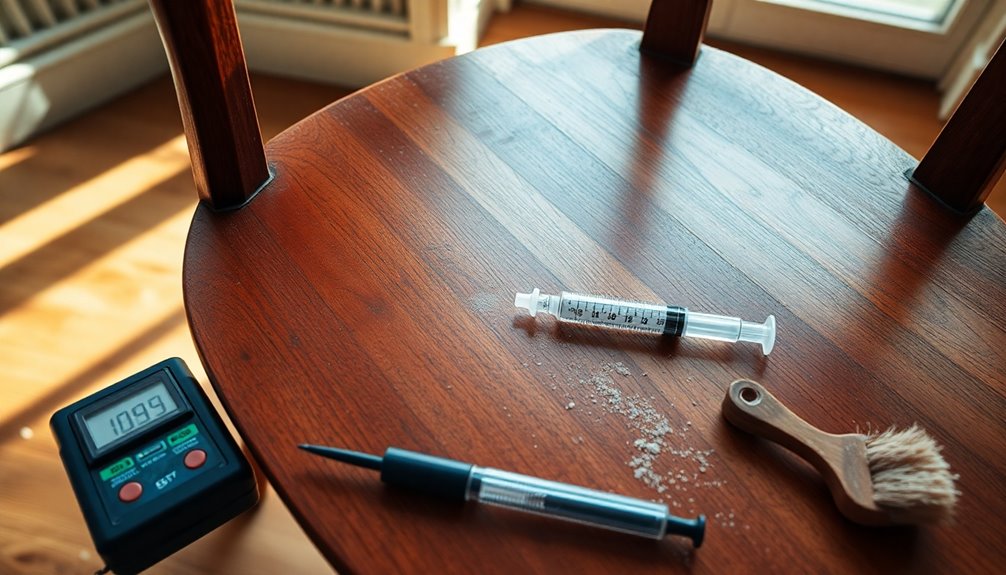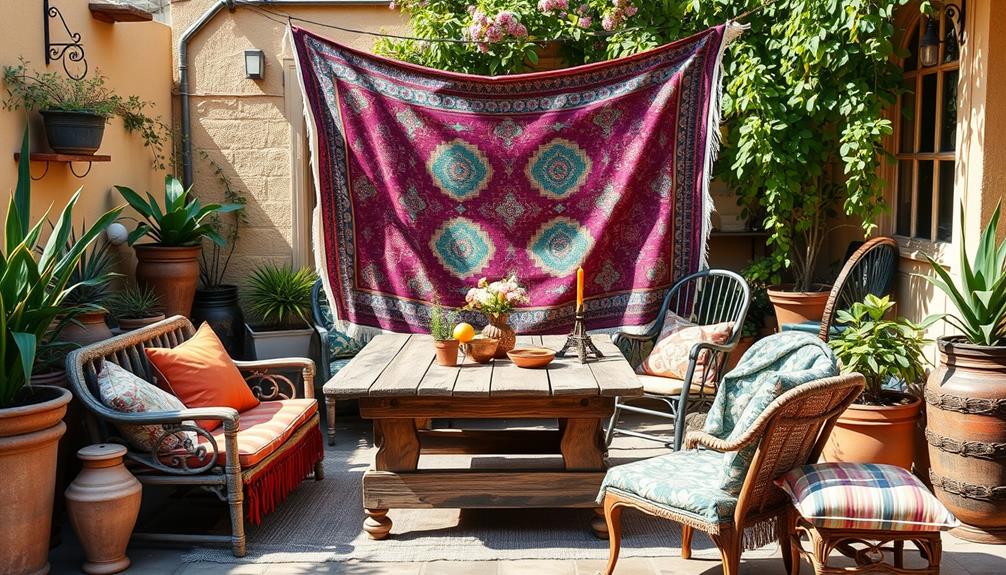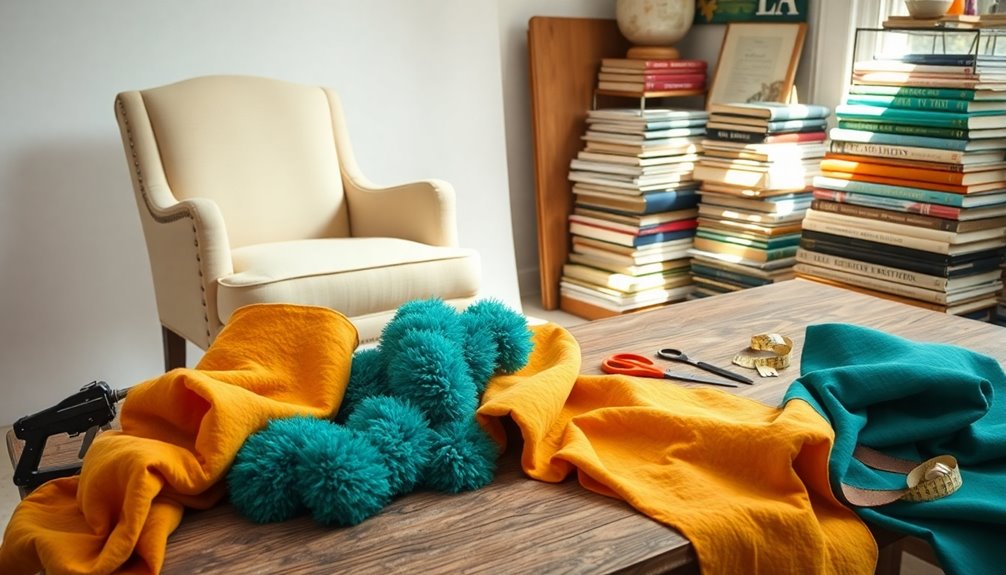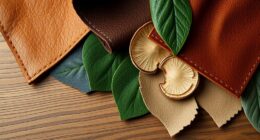To cover your sofa, start by measuring its dimensions accurately. Choose a durable fabric that suits your decor and gather tools like scissors and a staple gun. Clean the sofa to remove any dust. Cut the fabric, leaving extra to tuck in securely. Test fit each piece before attaching it, ensuring patterns align for a polished look. Use the staple gun to secure the fabric, tucking it into crevices for a neat finish. Finally, add decorative cushions and throws for style. With these tips, you can achieve a great-looking sofa cover that lasts—there’s more to explore on enhancing your sofa’s appeal! Consider the maintenance of the fabric you choose, as some materials may require special care or regular cleaning to maintain their appearance. Additionally, think about how to choose a sofa cover that complements the overall aesthetic of your room while providing comfort and durability. With the right fabric and attention to detail, your newly covered sofa can become a stunning centerpiece in your living space.
Key Takeaways
- Measure the sofa dimensions accurately to ensure a proper fit for the fabric cover you choose.
- Select durable upholstery-grade fabric that complements your existing decor and is easy to clean.
- Cut fabric pieces according to measurements, leaving extra for tucking and securing into crevices.
- Use a staple gun for secure attachment and consider fabric glue for non-stapled areas to achieve a clean finish.
- Regularly maintain the fabric by vacuuming and spot cleaning to preserve its appearance and longevity.
Introduction

Keeping your sofa looking great requires more than just a stylish cover. You'll want to make weekly vacuuming and dusting a habit, use fabric-specific cleaning techniques, and know how to treat those pesky red wine spills. With a little effort, you can maintain both the appearance and longevity of your sofa cover.
Weekly Vacuuming and Dusting
To maintain a fresh and inviting living space, vacuuming your sofa at least once a week is essential. This routine helps remove dust, dirt, and allergens that accumulate in the fabric, contributing to a cleaner environment for you and your family. Use a vacuum attachment designed for upholstery to effectively reach crevices and lift debris without damaging your sofa cover.
In addition to vacuuming, dusting your sofa with a microfiber cloth is a great practice. It helps lift surface dust and prevents it from settling deep into the fibers, keeping your sofa looking its best. If you have pets, consider vacuuming more frequently to manage pet hair and dander, which can easily become embedded in the upholstery.
Incorporating a routine of vacuuming and dusting not only prolongs the life of your sofa but also enhances your overall home hygiene and aesthetic appeal. By dedicating a little time each week to these tasks, you'll ensure your sofa remains a comfortable and attractive focal point in your living space, inviting relaxation and enjoyment for everyone.
Fabric-Specific Cleaning Techniques
When it comes to maintaining your sofa, understanding the specific cleaning techniques for different fabrics is crucial. For instance, to clean cotton upholstery, mix mild detergent with water, and apply it using a soft cloth. Be careful not to use too much moisture, as it can cause watermarks.
If your sofa is leather, start by wiping the surface with a damp cloth. Follow up with a specialized leather cleaner to tackle any stains, and don't forget to condition the leather afterward to keep it supple.
Microfiber requires a different approach. Use a dry sponge or soft brush to lift away dust and stains. For tougher marks, a mix of rubbing alcohol and water on a soft cloth works wonders.
Velvet needs extra care; gently clean it with a soft, dry cloth to avoid crushing the pile. For stains, test a small amount of water on an inconspicuous spot first.
Lastly, when it comes to synthetic upholstery, you can often clean it with soap and water. Just double-check the care labels, as some may require dry cleaning only.
Treating Red Wine Spills
Red wine spills can be a nightmare for sofa owners, but acting quickly can make all the difference. The first step is to grab a clean cloth and gently blot the spill. Avoid rubbing, as that can spread the stain further into your sofa's fabric. After blotting, sprinkle salt directly on the spill. Salt works wonders by absorbing the wine and drawing moisture out, which helps prevent staining.
Next, mix a cleaning solution using one part white vinegar and two parts water. Apply this solution to the stained area with a cloth, dabbing gently to lift the wine without damaging your sofa's fabric. If the stain remains stubborn, consider using a commercial upholstery cleaner designed specifically for your sofa's material. Always follow the manufacturer's instructions for application.
Before applying any cleaning solution, it's wise to test it on an inconspicuous area of the sofa first. This way, you can ensure it won't cause discoloration or damage. By following these steps, you can effectively treat red wine spills and keep your sofa looking its best.
Safeguarding Against Stains
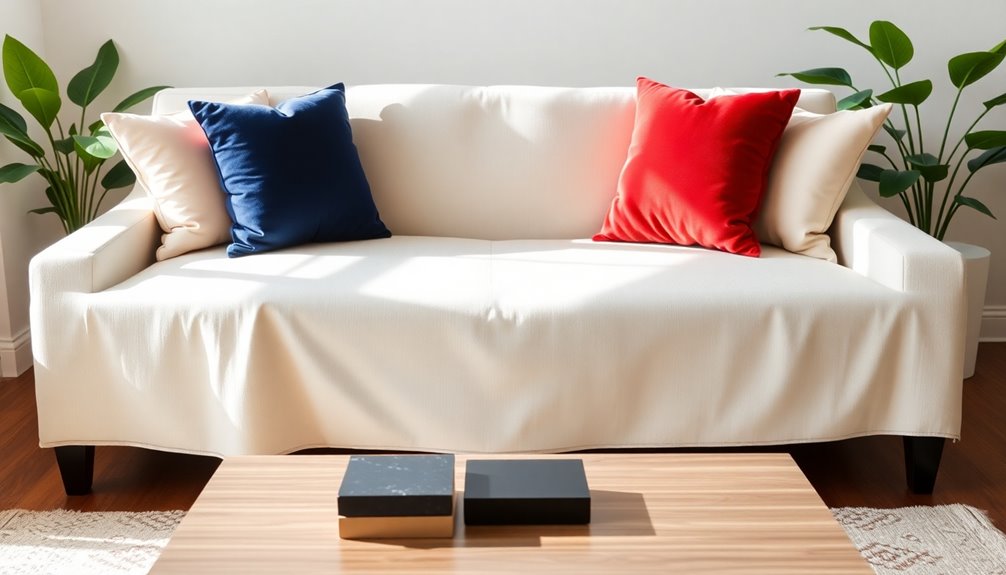
To keep your sofa looking fresh, consider scratch-resistant fabric choices that withstand everyday wear and tear. Layering textiles not only adds style but also provides extra protection against spills and stains. Don't forget to use coasters on armrests to prevent rings and marks from drinks. Incorporating natural materials in your textile choices can enhance durability and contribute to a cozy farmhouse aesthetic.
Scratch-Resistant Fabric Choices
Selecting the right fabric for your sofa can make a significant difference in its longevity and appearance, especially in homes with kids or pets. To ensure durability, consider materials like microfiber, polyester, or canvas. These fabrics are known for their scratch-resistant qualities, making them ideal choices for your active household.
Another key factor is to look for fabric finishes, such as Teflon or Scotchgard. These treatments provide additional protection against stains and spills, simplifying cleaning and maintenance. Tightly woven fabrics are also a smart choice; they resist snagging and tearing, which helps your sofa last longer.
If you love the look of leather, consider scratch-resistant alternatives like bonded leather or faux leather. They mimic the aesthetic of traditional leather while offering better ease of cleaning and greater resistance to wear.
To maintain your sofa's scratch resistance, regularly apply a fabric protector spray. This not only repels stains but also enhances the overall durability and appearance of your upholstery. With the right fabric choices, you can keep your sofa looking fresh and new, even in the busiest of homes.
Layering Textiles for Style
Creating a harmonious and stylish living space involves more than just choosing the right sofa; it's about how you layer textiles to enhance both aesthetics and functionality. Layering textiles, like throw blankets and decorative pillows, not only adds visual interest but also provides an extra layer of protection against stains and wear. Opt for fabrics such as wool or microfiber for your throws, as these materials are comfortable and resistant to stains—ideal for homes with kids or pets.
Incorporating a variety of textures and patterns makes it easier to disguise any potential spills on your couch. Regularly rotating and rearranging your layered textiles can help maintain their appearance, distributing wear evenly across surfaces. This simple practice can extend the lifespan of your decor. Additionally, consider using effective wall organization solutions to create a cohesive look that complements your layered textiles.
Don't forget to choose machine-washable couch covers and throw blankets for easy cleaning. This ensures your layered setup remains fresh and presentable, no matter what life throws at you. By thoughtfully layering textiles, you can create a stylish, inviting space that stands up to everyday challenges while reflecting your personal style.
Using Coasters on Armrests
Layering textiles adds style and protection to your living space, but don't overlook the importance of using coasters on your sofa's armrests. Coasters are your first line of defense against moisture rings and stains from drinks, ensuring your sofa stays in pristine condition. By placing coasters on your armrests, you protect the fabric and finish, extending your sofa's lifespan.
Coasters come in various materials like cork, wood, and silicone, so you can choose options that complement your sofa's aesthetic while providing essential protection. Plus, many coasters feature non-slip designs, which keep them securely in place and enhance their protective function.
Encouraging your guests to use coasters cultivates a culture of care for your furniture, helping to minimize accidental spills and damage. Regularly using coasters can also save you money by reducing the need for extensive cleaning or even reupholstering, which can cost hundreds of dollars. Moreover, understanding relationship dynamics can help you communicate the importance of using coasters to your guests effectively.
Incorporating coasters into your living space isn't just practical; it's a simple way to maintain your sofa's beauty while enjoying your favorite drinks. Protect your investment and keep your sofa looking great for years to come!
Cushion Foam Replacement
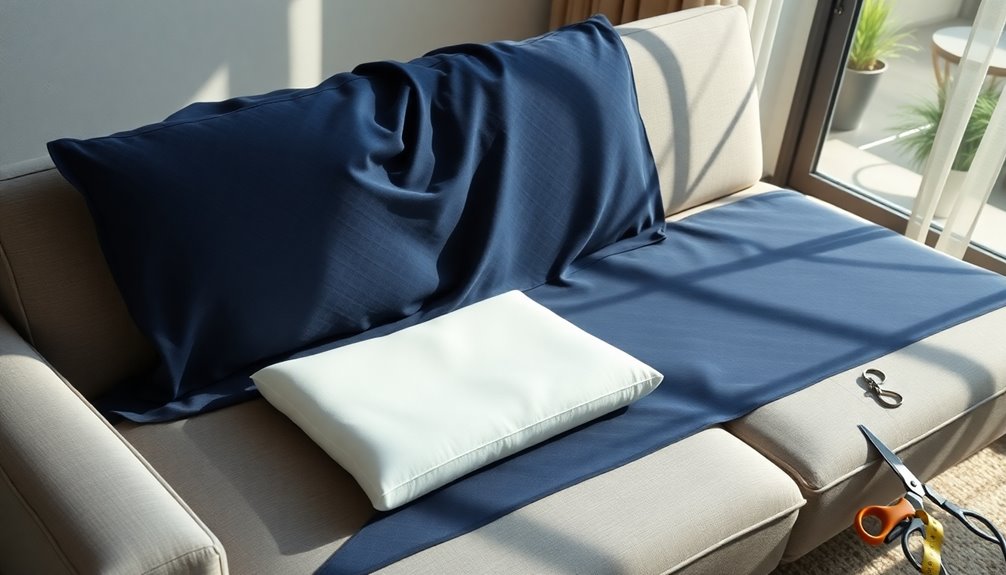
If your sofa cushions are sagging, it's time to consider foam replacement for better support and comfort. Choosing the right type of foam can breathe new life into your seating, ensuring you enjoy every moment spent on your couch. By revitalizing your cushion support, you not only enhance comfort but also extend the lifespan of your sofa.
Cushion Sagging and Support
Sagging sofa cushions can turn your once-comfortable seating into a source of frustration. To tackle this issue, consider replacing the foam in your cushions. Using high-density foam can restore firmness and support, enhancing comfort significantly. Start by measuring your existing cushions to find the right foam size, usually about 4 to 6 inches thick for adequate support.
When selecting foam, think about a combination that includes a softer top layer for comfort and a firmer base layer for support. This mix creates a balanced seating experience that feels great. You can find upholstery-grade foam at fabric stores or online, with prices ranging from $30 to $100, depending on size and quality.
To maintain your newly replaced cushions, regularly rotate and flip them. This practice helps prevent uneven wear and extends the lifespan of both the foam and the overall cushion structure. Additionally, consider investing in couch covers or sofa slipcovers to protect your cushions from wear and tear, keeping everything looking fresh. With the right cushion foam replacement and protective covers, you'll enjoy a revitalized sofa for years to come. Moreover, using airless paint sprayers can make the process of refreshing your sofa's surrounding decor significantly easier and more efficient.
Leather Conditioning Techniques
Keeping your leather sofa looking its best requires regular conditioning to prevent drying and cracking. You should apply a leather conditioner every 3 to 6 months. This practice keeps the leather hydrated and supple, minimizing wear and tear over time. When it comes to replacing the cushion foam, opt for high-density foam that provides both durability and comfort. A thickness of 4 to 5 inches is typically ideal, but it depends on how firm you want your new piece to feel.
Before purchasing the new foam, accurately measure the existing cushions to ensure a snug fit within the couch cover. Consider adding an extra inch in width and length for easier placement. To protect your new foam from spills and stains, use a fabric or vinyl cover; this will extend its lifespan and maintain the cushion's shape. For the best comfort, remember to break in the new foam by sitting on the cushions regularly. This helps the foam conform to your body, making your leather sofa even more enjoyable to use.
Revitalizing Cushion Support
Regularly replacing cushion foam can dramatically improve the comfort and support of your sofa. To start, measure the thickness and dimensions of your existing cushions. You'll want to choose foam that's typically about 2-4 inches thick for optimal support. High-density foam is your best bet for lasting durability and resilience, ensuring you enjoy your sofa for years to come.
Consider enhancing your cushions further by adding a layer of batting or dacron on top of the foam. This extra layer adds softness and helps the foam contour to your cushion covers, providing a plush feel. When selecting the foam, you have options ranging from standard polyurethane to advanced materials like memory foam or latex, which offer enhanced comfort.
Once you've chosen the right cushion foam, properly cut and shape it to fit snugly within your cushion covers. This not only ensures a neat appearance but also prevents the foam from shifting during use, maintaining that all-important support. By investing in quality cushion foam, you'll revitalize your sofa, making it a cozy centerpiece in your living space.
Cushion Shape Alterations

Transforming the shape of your sofa cushions can breathe new life into your furniture and enhance its comfort. To start, measure your existing cushions and decide on the new cushion shapes you want. Once you have that, cut new foam or batting to the desired dimensions, using upholstery foam that matches the original thickness—typically between 2 to 4 inches depending on your comfort preferences.
For accuracy, consider using a template, like cardboard cutouts, to outline your new shape. This will help you achieve a uniform appearance across all cushions. When you're ready to cover your altered cushions, choose fabric that accommodates the new shape and allows for tucking or pleating to keep everything looking neat.
To make your cushions even more functional, secure the new covers with Velcro or zippers. This way, you can easily remove and clean them when necessary, ensuring your DIY sofa remains fresh and appealing. With these steps, you'll not only enhance your sofa's aesthetics but also improve its overall comfort, giving your living space a stylish update. Additionally, consider using natural materials like cotton or linen for your cushion covers to maintain a cohesive farmhouse aesthetic.
Seasonal Fabric Rotation Tips

After updating your sofa cushions, it's a great time to think about how seasonal fabric rotation can further enhance your living space. Start by selecting lighter fabrics like cotton or linen for those warmer months, switching to heavier materials such as velvet or wool as temperatures drop. This not only boosts comfort but also elevates your decor style.
Consider using machine-washable slipcovers to make seasonal changes hassle-free. This way, you won't have to worry about dry cleaning, allowing you to easily refresh your sofa whenever you want. In summer, incorporate bold colors and vibrant patterns for a lively atmosphere. When winter rolls around, opt for neutral tones to create a cozy, inviting feel.
When it's time to store off-season fabrics, use breathable bags to protect them from dust and moisture. This ensures your slipcovers are in good condition for future use. Aim for versatility by choosing slipcovers that can be easily mixed and matched with seasonal throw pillows and blankets. By doing this, you'll maintain a fresh look in your living space all year round, adapting effortlessly to the seasonal changes.
Conclusion
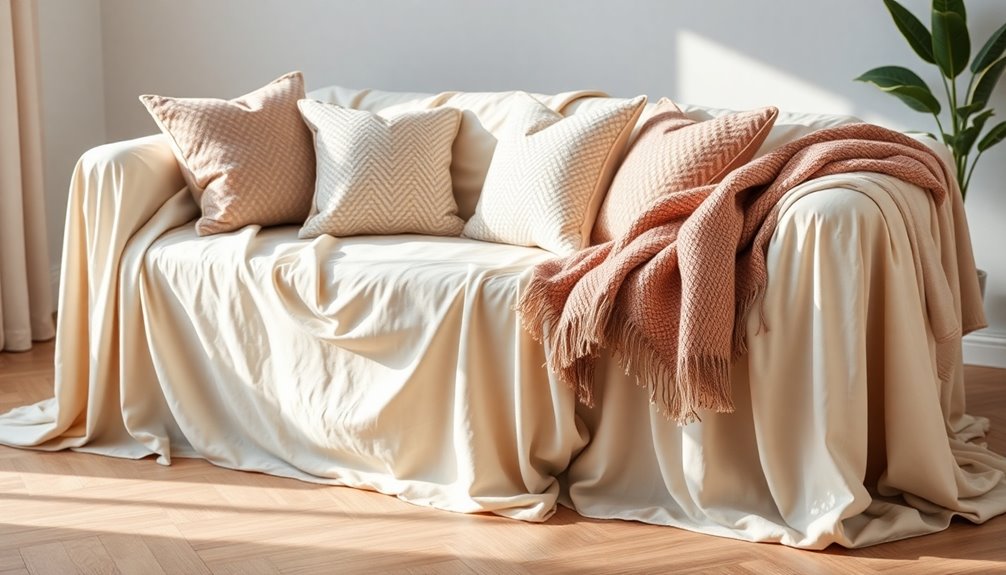
Covering your sofa is an effective way to enhance both its appearance and longevity. Whether you choose DIY slipcovers or opt for store-bought varieties, you can easily give your couch a new look that suits your style. Remember, accurate measurements are crucial when selecting or creating your slipcovers. For a standard 7-foot sofa, you'll need around 14 yards of fabric, plus extra for cushions.
If sewing isn't your thing, don't worry! No-sew methods, like using blankets or sheets, offer quick and cost-effective solutions that don't require any special skills. Slipcovers should be easy to maintain, ideally machine washable, allowing for effortless cleaning and seasonal updates.
Consider custom slipcovers for a perfect fit if your sofa has unique shapes; just be prepared for a higher investment, ranging from $500 to $3000, depending on materials and labor. Ultimately, covering your sofa not only protects it from wear but also allows you to refresh your living space with minimal effort. So, gather your measurements, choose your fabric, and transform your sofa into a stunning focal point in your home!
Frequently Asked Questions
How Can I Cover My Couch Without a Couch Cover?
You can easily cover your couch without a traditional couch cover by using king-sized sheets or large blankets. Just drape them over the couch for a simple, washable solution. For a unique flair, try wrapping cushions in mismatched throws or tablecloths. If you're looking for a polished look, secure drop cloths with a staple gun or no-sew techniques like safety pins. Decorative throws and quilts can also refresh your space seasonally.
How to Use a Blanket as a Sofa Cover?
To use a blanket as a sofa cover, start by choosing a large blanket, like a king-sized one, for full coverage. Drape it over your sofa, making sure it covers the back, arms, and seat. Smooth out any wrinkles for a tidy look. Tuck the edges into the sofa's crevices to secure it. If needed, use blanket clips or decorative pillows to keep it in place, ensuring it stays put during use.
Can You Put a Slipcover on Any Couch?
You can generally put a slipcover on most couches, but it depends on your couch's shape and cushion style. Before you choose a slipcover, measure your couch to ensure a proper fit. Relaxed-fit options give a casual look and can adapt to various shapes, while form-fitting choices offer a sleek appearance but need precise sizing. Keep in mind that some unique designs might require custom-made slipcovers for the best results.
How to Disguise a Sofa?
To disguise a sofa, you can use fitted slipcovers in a solid color or pattern that completely envelop it. Drape oversized throws for a casual look and easy cleaning. Add decorative pillows in coordinating designs to shift focus away from the sofa's original appearance. If you're feeling adventurous, consider fabric dye for a bold transformation. Lastly, arrange side tables or plants around it to minimize visibility and highlight other elements in your space.

